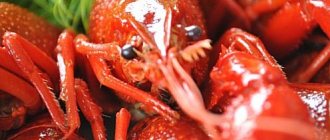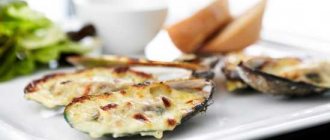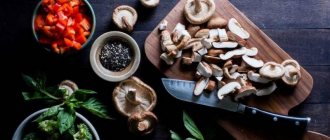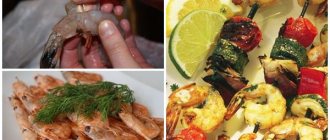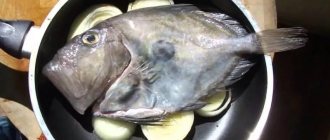What are seafood in shells called? Names and types of seafood
First, let's highlight those who live in the sea, but still do not belong to seafood. You should immediately remove fish from the list, as well as mammals - whales and dolphins, if you suddenly get hold of such an exotic product. All other varieties that humans eat are classified into three main groups.
Shellfish
The essence of mollusks is best described by how they are called in Russian - soft-bodied, that is, lacking a bony skeleton in the thickness of the body. Moreover, some of them live in shells, having at least some protection from the outside world, while others seem completely defenseless against any physical influence. Let us immediately note that most land mollusks are not edible, but with the inhabitants of reservoirs the situation is completely different.
Most species of such creatures have remained popular food for many peoples for thousands of years, and in recent decades they have become available almost everywhere.
- Thus, historically, bivalve mollusks were the first to be consumed as food, whose share in the total number of soft-bodied mollusks is no more than one fifth. The choice fell on them due to the ease of their extraction, since many of these mollusks live in the shallows. Of the bivalves, the best known are mussels and oysters.
- The absolute majority of all mollusks on the planet belong to gastropods, but they are relatively little known as food, and even experienced gourmets cannot always boast that they know their taste. However, a fairly well-known snail belongs to this category, but if we talk specifically about seafood, then the list of the main commercial species is as follows: limpet, abalone, whelks, littorinas, sea hares.
- We must not forget about cephalopods, which make up a small part of the mass as a whole, but represent a significant part of edible mollusks. Of all the soft-bodied squids that can be eaten, the taste of these creatures is the most widely known, because the same dried squids are sold everywhere. Among the more unusual delicacies that are increasingly appearing on supermarket shelves, it is also worth highlighting octopus and cuttlefish.
What is seafood with rice called? Seafood pilaf
Rice with seafood. Seafood rice is a great option for breakfast, lunch or dinner, which is very easy and simple to prepare. This light, appetizing, tasty and healthy dish will not leave anyone indifferent! And the key to the success of this dish will be quality seafood. Of course, it turns out very tasty with the most ordinary seafood cocktail, but if you make such a “cocktail” yourself from pre-purchased selected mussels, shrimp, octopus, squid and other seafood, the finished dish will turn out even more solid. Valencia is considered the birthplace of seafood rice, so it is a traditional Spanish dish! It is not capable of causing serious harm to the figure and brings many benefits to the body! Rice is very rich in iron, magnesium and calcium, which contribute to the proper functioning of the stomach and strengthen the body, and seafood boasts protein, iodine, zinc, phosphorus and fatty acids - these substances perfectly help strengthen bones and muscles, and also prevent cancer and various thyroid diseases glands. To prepare this dish, it is best to take long-grain rice - it cooks much better. And if you can buy steamed or black rice, it will be just great! Any rice should be thoroughly washed: the cleaner it is, the better its taste. And so that it always turns out crumbly, it is pre-soaked in cold water (for an hour or two). As for seafood, they should ideally be frozen - at subzero temperatures, all small parasites and their larvae that might have been accidentally removed from the sea die in them. If fresh, non-frozen seafood is purchased, then it must be caught on this very day. As a rule, seafood is pre-fried in oil (and before that you can lightly boil it), and this should be done until there is no water left in it. Many housewives also actively use spices - paprika, salt, garlic, as well as red and black pepper are perfect for preparing rice with seafood. Rice with seafood can be served as a separate dish or in combination with fresh vegetables or a light vegetable salad. You can put soy sauce on the table, as well as a plate of soft bread. And white wine helps to highlight the rich taste of seafood!
What can you make from a frozen sea cocktail?
Recipes with frozen sea cocktails can be very diverse and original.
- Seafood can be fried in a frying pan with the addition of garlic, onions, vegetables, or simply with salt, pepper and, if desired, lemon juice.
- To serve independently or before adding to various dishes, the cocktail is boiled in salted water, adding herbs and spices to taste.
- Salads containing seafood are incredibly tasty; they can be dressed with a classic dressing of oil and lemon juice or mayonnaise.
- Seafood performs excellently in dishes with rice, pasta, when baking pizza and other snacks.
How to cook a frozen seafood cocktail in a frying pan?
Easily prepare a frozen seafood cocktail in a frying pan. The product does not need to be defrosted first, but can be heat treated immediately. As soon as the ice has melted, the moisture has evaporated, and the seafood has become soft, you can remove the container from the stove, serve it, or use it to create a multi-component dish.
- sea cocktail – 0.5 kg;
- garlic – 3-4 cloves;
- olive oil – 4 tbsp. spoons;
- salt pepper.
- Crushed garlic cloves are fried in oil in a frying pan.
- Seafood is placed in aromatic oil, fried after thawing for no more than three minutes, and seasoned.
- Seafood is served with vegetable salad, herbs, and suitable sauce.
How to cook a frozen seafood cocktail?
The following recommendations are for those who do not yet know how long to cook a frozen seafood cocktail so that all ingredients retain their delicate and soft taste and natural aroma. Boiled-frozen components just need to be brought to a boil, and raw-frozen ones need to be boiled after boiling again for no more than five minutes.
- sea cocktail – 0.5 kg;
- water – 1 l;
- greens – 1 bunch;
- salt – 1/3 teaspoon;
- bay, peppercorns.
- Bring water to a boil, add salt, add laurel, pepper, and herbs.
- Add a sea cocktail, boil for 5 minutes, drain in a colander.
- Seafood is served with lemon juice, sauce, and herbs.
How to make a frozen seafood cocktail with cream?
When considering frozen seafood cocktail dishes for further preparation, special attention should be paid to versions containing creamy sauce. Cream favorably emphasizes the delicate taste of seafood, making it even more tender, and additional seasonings and spices give the dish a slight piquancy.
- sea cocktail – 0.5 kg;
- cream – 150 ml;
- soy sauce – 2 tbsp. spoons;
- garlic – 4 cloves;
- onion – 1 pc.;
- salt, pepper, vegetable oil.
- Thaw the cocktail, add a spoonful of soy sauce, and leave for 30 minutes.
- Fry the onion in oil, add garlic, brown for a minute.
- Pour in cream, soy sauce, pepper and heat for a couple of minutes.
- Seafood is fried separately and sauce is added.
- Simmer the frozen seafood cocktail in creamy sauce for 5 minutes.
How to marinate a frozen seafood cocktail?
Preparing a frozen seafood cocktail using the recommendations below will provide a versatile snack that can be enjoyed with a slice of bread or used to create all kinds of salads. If desired, the composition of the marinade can be supplemented with spices to your taste or other herbs.
- sea cocktail – 0.5 kg;
- soy sauce – 50 ml;
- vegetable oil – 2 tbsp. spoons;
- water – 1.5 l;
- salt – 1 tbsp. spoon;
- sugar – 0.5 tbsp. spoons;
- vinegar 9% - 60 ml;
- black pepper – ¼ teaspoon;
- lemon – 0.5 pcs.;
- parsley - 0.5 bunch.
- Boil the cocktail, add lemon juice and parsley.
- Combine water, salt, sugar, pepper, oil and vinegar in a saucepan and bring to a boil.
- Place the cocktail in jars, pour a spoonful of soy sauce into each jar, pour boiling marinade over everything, seal it and put it in the cold after cooling.
Frozen seafood salad
The following recipe for frozen seafood cocktail salad can be used as a base option to create a unique version of the appetizer dish. The components included in the composition can be supplemented with other vegetables, herbs, seasoned with a different dressing, replacing the proposed components with new additives.
- sea cocktail – 400 g;
- cucumbers – 2 pcs.;
- tomatoes – 4 pcs.;
- bell pepper – 1 pc.;
- garlic – 2 cloves;
- vegetable oil – 2 tbsp. spoons;
- lemon juice and soy sauce - 1 tbsp. spoon;
- salt, pepper, herbs.
- The seafood cocktail is boiled or fried in a frying pan for two minutes.
- Chop cucumbers, tomatoes, peppers and garlic.
- Mix soy sauce, lemon juice and oil, add salt and pepper.
- Combine seafood, vegetables and dressing in a salad bowl, mix and season with herbs.
How to prepare a frozen seafood cocktail for beer?
Read on to learn how to quickly prepare a frozen seafood cocktail for beer. The appetizer acquires its piquant taste and aroma by pre-marinating it in a mixture of soy sauce and lemon juice. If desired, you can add a little dried or fresh garlic, pepper, and other seasonings to the marinade.
- sea cocktail – 400 g;
- soy sauce – 2 tbsp. spoons;
- lemon juice – 1 tbsp. spoon;
- olive oil – 2 tbsp. spoons.
- Defrost the cocktail, rinse, and allow to drain.
- Add soy sauce and lemon juice, mix, leave in the refrigerator for half an hour.
- Place the seafood on a sieve, allow to drain and place in heated oil.
- Fry the frozen sea cocktail for beer over high heat for 2-3 minutes, stirring.
Frozen sea cocktail pilaf
The method presented below for preparing a frozen sea cocktail will allow you to get an independent nutritious dish that you can qualitatively feed your family at dinner or serve with dignity to guests. Long grain rice must be used. The Basmati variety or its mixture with wild rice is suitable.
- sea cocktail – 700 g;
- rice – 150 g;
- dried ginger – 1 teaspoon;
- carrots and onions – 1 pc.;
- lemon – 1/3 pcs.;
- vegetable oil – 50 ml;
- salt, pepper, herbs.
- Fry the cocktail in hot oil for a minute.
- Add ginger, carrots and onions and fry for 5 minutes.
- Add rice, add salt and pepper.
- Pour boiling water over the components until the mixture is covered by 1.5 cm.
- Simmer the dish over low heat for 30 minutes under the lid, let it brew.
- Add lemon juice, stir the dish and serve.
How to make frozen seafood cocktail with spaghetti?
If you prepare a frozen seafood cocktail with cream and add the resulting sauce to pasta, you can enjoy a great version of a dish from Italian cuisine. The recommendations from the following recipe and the proven proportions of the components proposed in it will help you effectively cope with the task.
- sea cocktail – 500 g;
- spaghetti – 250 g;
- cream – 250 ml;
- cheese – 200 g;
- Italian herbs - 1 tbsp. spoon;
- vegetable oil – 40 g;
- garlic – 2 cloves;
- salt, pepper, herbs.
- Defrost the seafood cocktail, boil for 1-2 minutes, and allow to drain.
- Fry garlic in oil and discard.
- Add seafood, brown for a minute.
- Pour in cream, season with salt, pepper, herbs, stir in grated cheese.
- Mix spaghetti with frozen seafood cocktail in sauce and serve with greens.
Frozen seafood cocktail with tomatoes
While studying recipes for frozen seafood cocktails, your eye is drawn to the appetizing combination of seafood with fresh tomatoes. Having completed one of the recipes, you will be able to appreciate not only the magnificent appearance of the culinary composition, but also its delicious taste, the degree of sharpness and piquancy of which can be adjusted.
- sea cocktail – 800 g;
- tomatoes – 150 g;
- iceberg and Chinese cabbage - 1/3 head each;
- soy sauce – 20 ml;
- vegetable oil – 60 g;
- garlic (optional) – 1 clove;
- salt, pepper, herbs.
- Place the cocktail in a frying pan with oil and fry until the moisture evaporates.
- Add soy sauce and garlic and heat for a couple of minutes.
- After cooling, add iceberg and cabbage to the seafood, add tomatoes, season with salt, pepper, oil and herbs.
What are seafood called? How to choose seafood that you can eat without risk to your health
- Guys, we put our hearts into Bright Side. Thank you for revealing this beauty. Thanks for the inspiration and goosebumps. Join us on Facebook and VKontakte
Dariush Mozaffarian, a professor at the oldest Friedman School of Nutrition at Tufts University, published a study in which he divided all foods into several groups based on how harmful or beneficial they are to humans. Seafood fell into the first group, where he included food with proven and undeniable benefits.
With the development of logistics and international trade, high-quality seafood has become available to residents of cities far from the sea. But since this happened relatively recently, many people avoid counters with sea reptiles. Bright Side decided to put together a small guide to the most popular mollusks and crustaceans: perhaps it will help you include them in your diet more often.
Shrimps
There has been some confusion in the Russian language with shrimps: we call all small crustaceans without claws this way, adding only “big” or “small”. In English, marine shrimp are called shrimps, and freshwater shrimp are called prawns. They differ not only in size. These are completely different species, no closer to each other than crab and lobster.
How to choose: shrimp usually arrive on domestic shelves in boiled frozen form, less often in fresh frozen form. When purchasing, pay attention to their tails: if they are straightened, it means the shrimp died before heat treatment and it is better to leave them on the counter. A black head, dark spots, and uneven color indicate that the shrimp has begun to deteriorate.
For fresh shrimp, check for the presence of antennae and limbs - they should be in place. When purchasing frozen shrimp, choose those that have been dry frozen.
As for how to cook shrimp, it’s unlikely that anyone will tell you about it better than Forrest Gump’s colleague.
Lobsters and lobsters
Let's make things clear right away: lobster and lobster are the same animal, the names just come from different languages. A lobster is a sea crayfish with huge claws. The lobster is more like an overgrown shrimp. Lobster was once the food of the poor and prisoners, but now it is perhaps the most valuable crustacean.
Lobsters are cheaper, and some unscrupulous restaurateurs sometimes pass them off as lobsters. Lobsters and lobsters taste similar, but there is a difference in texture (lobster meat is more like shrimp). Most often, lobsters are eaten boiled, with the meat removed from the tail and limbs.
How to choose: the most delicious lobsters are very young, no older than 10 years (in general, they can live up to 70), weighing about 700 g. Experts advise preparing soups from females with caviar - this way the taste of the broth will be more intense. They can be distinguished by their wider tail and a number of other characteristics.
Of course, the lobster must be live or frozen. A lobster that dies before heat treatment is dangerous because bacteria begin to rapidly multiply in it, releasing toxins. And by the way, beware of their claws: it will not be difficult for a large individual to break a person’s finger.
What are the benefits of seafood?
For the average resident of our latitudes, a seafood salad turns out to be a festive dish, and a soup containing seaweed is a complete curiosity. However, globalization brings culinary traditions of other peoples into our everyday life, thereby ensuring the opportunity to take the maximum of their positive properties from food products. What qualities are seafood traditionally famous for?
Seafood is an excellent alternative to meat dishes only because it is not inferior to them in protein content. However, the advantage of seafood is that the protein they contain is much easier and faster absorbed by the human body. On average, the calorie content of seafood is estimated at 60-120 kcal per 100 grams.
Seafood is not only a complete source of protein, but also an unparalleled source of polyunsaturated fatty acids, especially Omega-3. Everyone knows that these substances contribute to the full function of the brain, strengthen blood vessels and improve their elasticity, at the same time reduce the level of harmful cholesterol in the blood and normalize intercellular metabolism, and in the long term they can protect against malignant tumors. A sufficient amount of Omega-3 in the body ensures stabilization of the psychological background and improvement of mood, which is perhaps why residents of oceanic regions are so positive and minimally susceptible to depression.
It is known that our body needs a certain amount of certain vitamins and microelements every day - some to a greater extent, some to a lesser extent. A thermally processed seafood cocktail (seafood mix, sold in any supermarket) allows you to cover the body’s daily need for such substances as:
- vitamin A,
- vitamin E,
- B vitamins,
- iodine,
- calcium,
- iron,
- phosphorus,
- potassium,
- sulfur,
- zinc,
- selenium.
It is the content of the last two microelements, that is, zinc and selenium, that makes seafood an excellent aphrodisiac. Penetrating into the human body, zinc and selenium ensure the production of testosterone, and this awakens libido.
Nutritionists prescribe the “marine” diet to those who suffer from diseases of the cardiovascular and digestive systems, as well as excess weight.
When talking about seafood, culinary specialists and nutritionists mean any seafood suitable for human consumption, that is, edible products removed from the depths of the world's oceans, with the exception of vertebrates, that is, fish and whales. This means seafood is shellfish, shrimp, squid, octopus, crab, lobster, and lobster. It would also be useful to consider in detail the benefits and harms of seaweed and red and black caviar.
Shrimps
This seafood usually goes on sale boiled and frozen; the reddish-pink bodies just need to be thawed. Shrimp on the shelves with grayish and greenish colors means a fresh, only chilled product. Shrimp are also popular on sale as part of sea cocktails containing scallops, squid, and mussels. They are served as a snack boiled with lemon, lime and a variety of sauces (chili, tartar, paprika, soy sauce). Shrimp are also used to make a variety of pastes, cocktails, canapés, sandwich butter, and added to sushi, soups and salads.
Among the advantages of their composition are:
- content of essential amino acids,
- content of B vitamins,
- iodine content (good for the thyroid gland),
- magnesium and potassium content (good for the cardiovascular system),
- zinc and selenium content (useful for erectile function),
- Shrimp in the diet is an opportunity to normalize metabolism, reduce the risk of developing allergies and the risk of cancer.
There are also disadvantages to such a product as shrimp:
- they contain a large amount of cholesterol, unless there is a clear opinion about whether this is “good” or “bad” cholesterol,
- Abuse of shrimp can aggravate allergic reactions and even cause intolerance,
- shrimp living in polluted waters are capable of accumulating mercury in their bodies.
Squid
Squid goes on sale in a variety of forms - canned, fresh frozen, chilled, dried. Only the squid carcass is used for food; it is important to peel off the skin. Dishes prepared from squid are quite varied - baked, fried, boiled, stewed, pickled and dried, canned dishes, and of course, as part of a frozen sea cocktail.
The advantages of squid meat are:
- the content of proteins and polyunsaturated fats, which promotes the development of muscle fibers, and therefore its consumption is indicated for people who want to increase muscle volume;
- the content of vitamins B6 and B3, which contributes to the normalization of metabolic processes and the excellent functioning of the gastrointestinal tract;
- potassium content can remove excess fluid from the body;
- selenium content can remove heavy metal salts from the body;
- taurine content helps reduce the level of “bad” cholesterol in the blood and stabilize blood pressure;
Minuses
- In pursuit of a healthy lifestyle, do not rush to consume dried squid - they are considered a snack containing a minimum of the above properties; on the contrary, it is a source of artificial enrichment with salts, which contributes to fluid retention in the body.
Mussels
Bivalve sea mollusks, of the variety of species of which only the common edible one, the Far Eastern giant (black shell), the Mediterranean-Black Sea, the Californian and several other less popular ones are suitable for food. Mollusks live in the waters of seas and oceans in temperate latitudes of both hemispheres. The muscle, mantle, and sometimes the liquid inside the shell are eaten. The meat has a sweetish taste and a subtle incomparable aroma. Shellfish are sold canned, fresh or frozen, and also as part of seafood cocktails.
The advantages of mussels are rightly considered:
- the content of vitamin B12, which takes an active part in the body’s absorption of other elements and vitamins;
- selenium content, a sufficient amount of which in the body is necessary for the complete absorption of iodine;
- the phospholipid content ensures normal liver function;
- the content of magnesium and potassium stimulates the process of hematopoiesis;
- it is a natural antioxidant that strengthens the immune system;
- Vitamin A content improves vision;
- helps prevent arthritis and cancer,
Mussels also have disadvantages, like any food product:
- can cause a very dangerous type of allergies - cross-allergy, caused by the similarity of allergenic structures;
- Contraindicated for bleeding disorders.
Sea kale
Perhaps this is the most popular seaweed consumed by humans as food. It has an original taste and many useful qualities. In Japanese cuisine, there are up to 150 culinary recipes with kelp - these are soups, salads and purees, beans and seafood are stewed with it, and vegetables are wrapped with it. In cuisine adapted to the Slavic eater, kelp is used to season borscht and pickles, stews; zrazy, cutlets, casseroles are prepared with it; dry kelp is ground into powder and used as a seasoning. However, any of these dishes will be perceived as a curiosity, except for the now popular salad, pickled seaweed with various additives (mushrooms, squid, carrots).
pros
- iodine content in organic form, which allows the body to provide its daily dose by consuming only 30 grams of cabbage;
- the content of an analogue of the thyroid hormone thyroidin makes cabbage doubly useful for the thyroid gland, thus normalizing its function in case of hypothyroidism and thyrotoxicosis;
- the content of mannitol and alginic acid ensures cleansing of the gastrointestinal tract from harmful substances and has a mild laxative effect on the principle of sorbents;
- Regular consumption of seaweed improves immunity,
- Regular consumption of seaweed normalizes metabolism and blood cholesterol levels;
- regular consumption of seaweed improves the functions of the cardiovascular, respiratory and central nervous systems;
- regular consumption of seaweed removes heavy metal salts and radionuclides from the body;
- Regular consumption of seaweed stimulates intestinal function;
- Regular consumption of seaweed helps restore prostate function in case of adenoma.
The disadvantages of seaweed are also associated with the iodine content in it; it should not be consumed by persons for whom iodine is contraindicated:
- with nephritis,
- during pregnancy,
- with furunculosis,
- with hemorrhagic diathesis,
- with individual intolerance to iodine and seafood.
